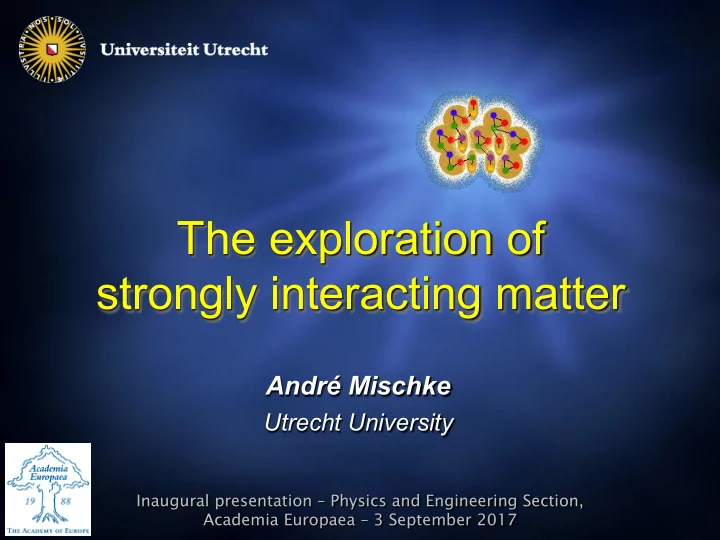

The exploration of strongly interacting matter André Mischk e Utrecht University Inaugural presentation – Physics and Engineering Section, Academia Europaea – 3 September 2017
Outline • About myself • Structure of matter • The quark-gluon plasma • The measuring apparatus • Heavy-quarks as a sensitive probe • Exciting future André Mischke (Utrecht University) 2
A few words about myself • Associate Professor of Physics at Utrecht University, the Netherlands • PhD at Goethe-University of Frankfurt, Germany • Studies in Physics and Mathematics at Philipps- University of Marburg, Germany • Married, one child • Founding chair, Young Academy of Europe • My specific research area: dynamical properties of the quark-gluon plasma • Deputy team leader, Dutch research group in the ALICE Collaboration André Mischke (Utrecht University) 3
What is matter? Visible universe (for us) Constituents of the universe André Mischke (Utrecht University) 4
Structure of (“visible”) matter Particle physics: search for the smallest (fundamental) constituents • Atoms • Atomic nuclei • Protons and neutrons • Quarks and gluons André Mischke (Utrecht University) 5
The Standard Model • Basis of particle physics - Elementary particles - Fundamental interactions - Generation of mass: Higgs Mechanism (Nobel Prize 2013) • Gravity is not described by the Standard Model • Still open questions - Strong interaction has a couple of properties that are not well understood. André Mischke (Utrecht University) 6
Quark confinement • Strong interaction Protons and described by Quantum- gluon neutrons are Chromodynamics colour neutral states. • Quarks quark - have colour charge - are confined (hadrons) α s ( r ) V ( r ) = − 4 + kr • Asymptotic freedom 3 r k = 1 GeV/fm How can we liberate quarks? Create a Quark-Gluon Plasma André Mischke (Utrecht University) 7
Different phases of matter Pressure + Heat à Quark Gluon Plasma André Mischke (Utrecht University) 8
Phase diagram Water Subatomic matter André Mischke (Utrecht University) 9
The Quark-Gluon Plasma (QGP) Phase transition to QGP Heat and pressure T ≈ 10 12 K ≈ 10 5 x sun’s core • Novel state of matter: quarks and gluons are liberated (deconfinement) • The hottest man-made matter • Evolution of the early universe - QGP may still exist in neutron stars sun André Mischke (Utrecht University) 10
Evolution of the Universe Quark-hadron phase transition 11
The Quark-Gluon Plasma (QGP) Phase transition to QGP Heat and pressure T ≈ 10 12 K ≈ 10 5 x sun’s core • Produce and study the QGP in the laboratory - sufficient large reaction volume - high density and temperature à Collisions of heavy atomic nuclei (lead or gold) • Large Hadron Collider at CERN: exploration of the plasma properties André Mischke (Utrecht University) 12
• Most powerful particle accelerator in the world • Working at cutting edge of science, technology and computing 9 km 100 m 13 13
• 1232 dipole magnets • Two counter-rotating beams • Operation with superfluid helium at 1.9K (~120 tons) • 8 Tesla bending field • 14 TeV proton-proton and 27 km circumference 5.5 TeV lead-lead collisions 14
The ALICE detector A L arge I on C ollider E xperiment lead beam lead beam Size : 16 x 26 meters Weight : 10.000 tons 18 Sub-detectors Dipole magnet B=0.5 T André Mischke (Utrecht University) 15
bang
Proton-proton collision at 13 TeV Tracks of produced particles detected in the measuring apparatus André Mischke (Utrecht University) 17
Lead-lead collision at 5.02 TeV “Run-2 data taking” from 2015-2018 Charm quark à D meson bound state André Mischke (Utrecht University) 18
Probing strongly interacting matter Collision of Reference • Heavy quarks heavy atomic nuclei measurement - are produced in pairs heavy quark - two types: charm and beauty proton proton Quark-Gluon - well-calibrated probes Plasma heavy quark • Interaction with the plasma → energy loss after collision André Mischke (Utrecht University) 19
D measurements in lead-lead collisions 2 Nuclear modification factor Nuclear modification factor 0 + + Average D , D , D* ALICE ALICE 1.8 Pb-Pb, = 2.76 TeV, | |<0.5 s y NN Yield AA ( p T ) 0-10% 1.6 R AA ( p T ) = with pp -extrap. reference p T N bin AA Yield pp ( p T ) 30-50% 1.4 p-Pb, = 5.02 TeV, -0.96 < <0.04 s y NN cms 1.2 ß No plasma 1 0.8 0.6 0.4 0.2 ß With plasma 0 0 5 10 15 20 25 30 35 40 (GeV/ ) Transverse momentum p c T ALI − PUB − 99591 • In lead-lead collisions: strong suppression of the yield when compared to “simple scaling” from proton-proton interaction • Still have to learn from theory about medium properties André Mischke (Utrecht University) 20
Summary Quark-Gluon-Plasma is a new form of strongly interacting matter Evolution of the universe Quark-Gluon Atomic nuclei Plasma ? Big Bang Particle accelerator: collision of heavy atomic nuclei • What are the properties of the interaction between quarks and gluons in the plasma phase? One of the central • Outlook: quantitative understanding of the questions in the energy loss and dissipation in the plasma NuPECC LRP report Andre Mischke (Utrecht) 21
Thank you André Mischke (Utrecht University) 22 22
Recommend
More recommend